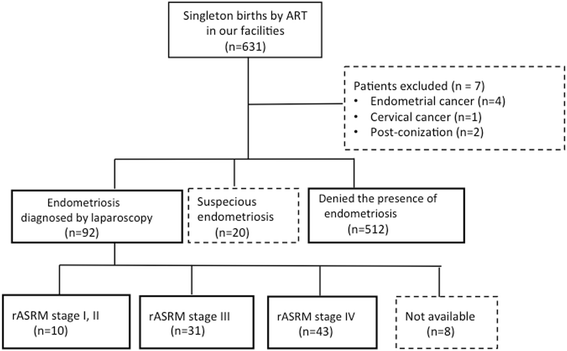Assisted reproductive technology pregnancy complications are significantly associated with endometriosis severity before conception: a retrospective cohort study
- PMID: 27809920
- PMCID: PMC5094074
- DOI: 10.1186/s12958-016-0209-2
Assisted reproductive technology pregnancy complications are significantly associated with endometriosis severity before conception: a retrospective cohort study
Abstract
Background: Endometriosis has been shown to be associated with second- to third-trimester pregnancy complications such as preterm birth and placenta previa, but the evidence is inconsistent. We hypothesized that endometriosis severity might affect these inconsistent results. Therefore we aimed to conduct a retrospective cohort study to elucidate whether endometriosis severity is associated with the incidence rates of adverse pregnancy outcomes.
Methods: The patients who achieved singleton pregnancy by assisted reproductive technology (ART) in our facility between March 2000 and December 2014 (N = 631) were included in this analysis. Among them, 92 women demonstrated surgically proven endometriosis, and 512 women were shown to not have endometriosis as a complication. Among the 92 cases of endometriosis, 10 were classified as revised American Society for Reproductive Medicine (rASRM) stage I and II, 31 cases were rASRM stage III, and 43 cases were rASRM stage IV; in 8 cases, the rASRM stage was unavailable. Logistic regression analysis was performed to calculate odds ratios (OR) and 95 % confidence interval (CI) for the rates of preterm birth, placenta previa, and small for gestational age. OR were adjusted by age, parity and the number of transferred embryos.
Results: First we confirmed the frequency of preterm birth and placenta previa were significantly increased in women with endometriosis (preterm birth OR, 2.08; 95 % CI, 1.07-3.89, placenta previa OR, 15.1; 95 % CI, 4.40-61.7), while the frequency of small for gestational age was not. Moreover, we found the frequencies of preterm birth and placenta previa were significantly increased in women with rASRM stage IV endometriosis compared to other two groups: women with rASRM stage I-III endometriosis (preterm birth OR, 7.40; 95 % CI, 1.83-50.3; placenta previa OR, 11.0; 95 % CI, 1.75-216.5) and women without endometriosis (preterm birth adjusted OR, 4.11; 95 % CI, 1.88-8.55; placenta previa adjusted OR, 39.8; 95 % CI, 10.1-189.1). There were no significant difference between women with rASRM I-III endometriosis and women without endometriosis.
Conclusions: We found that the frequencies of preterm birth and placenta previa were significantly increased in women with endometriosis, and the severity of endometriosis might have an adverse impact on ART pregnancy.
Keywords: Endometriosis; Placenta previa; Preterm birth; Revised American Society for Reproductive Medicine Stage.
Figures

Similar articles
-
Untangling the independent effect of endometriosis, adenomyosis, and ART-related factors on maternal, placental, fetal, and neonatal adverse outcomes: results from a systematic review and meta-analysis.Hum Reprod Update. 2024 Dec 1;30(6):751-788. doi: 10.1093/humupd/dmae024. Hum Reprod Update. 2024. PMID: 39049473
-
Endometriosis and risk of adverse pregnancy outcomes: a retrospective multicenter cohort study.Fertil Steril. 2025 Jan;123(1):137-147. doi: 10.1016/j.fertnstert.2024.07.037. Epub 2024 Jul 31. Fertil Steril. 2025. PMID: 39089610
-
Effects of Previous Laparoscopic Surgical Diagnosis of Endometriosis on Pregnancy Outcomes.Chin Med J (Engl). 2017 Feb 20;130(4):428-433. doi: 10.4103/0366-6999.199840. Chin Med J (Engl). 2017. PMID: 28218216 Free PMC article.
-
Increased risk of placenta previa and preterm birth in pregnant women with endometriosis/adenomyosis: A propensity-score matching analysis of a nationwide perinatal database in Japan.J Obstet Gynaecol Res. 2024 Mar;50(3):351-357. doi: 10.1111/jog.15849. Epub 2023 Dec 10. J Obstet Gynaecol Res. 2024. PMID: 38072834
-
Placenta previa and placental abruption after assisted reproductive technology in patients with endometriosis: a systematic review and meta-analysis.Arch Gynecol Obstet. 2018 Jul;298(1):27-34. doi: 10.1007/s00404-018-4765-x. Epub 2018 Mar 30. Arch Gynecol Obstet. 2018. PMID: 29602980
Cited by
-
Can Laparoscopic Cystectomy Improve Pregnancy Outcomes in Endometrioma? A Prospective Clinical Trial Study.Int J Fertil Steril. 2022 Aug 21;16(3):206-210. doi: 10.22074/IJFS.2021.521378.1066. Int J Fertil Steril. 2022. PMID: 36029058 Free PMC article.
-
Association between endometriosis and perinatal complications: a case-control study.BMC Pregnancy Childbirth. 2024 Aug 14;24(1):537. doi: 10.1186/s12884-024-06724-4. BMC Pregnancy Childbirth. 2024. PMID: 39143505 Free PMC article.
-
Obstetric Outcome After Surgical Treatment of Endometriosis: A Review of the Literature.Front Reprod Health. 2021 Dec 24;3:750750. doi: 10.3389/frph.2021.750750. eCollection 2021. Front Reprod Health. 2021. PMID: 36303984 Free PMC article. Review.
-
Women with Endometriosis, Especially Those Who Conceived with Assisted Reproductive Technology, Have Increased Risk of Placenta Previa: Meta-analyses.J Korean Med Sci. 2018 Jul 30;33(34):e234. doi: 10.3346/jkms.2018.33.e234. eCollection 2018 Aug 20. J Korean Med Sci. 2018. PMID: 30127709 Free PMC article.
-
Pregnancy outcomes in women with endometriosis and/or ART use: a population-based cohort study.Hum Reprod. 2022 Sep 30;37(10):2350-2358. doi: 10.1093/humrep/deac186. Hum Reprod. 2022. PMID: 36018266 Free PMC article.
References
-
- Igarashi TM, Bruner-Tran KL, Yeaman GR, Lessey BA, Edwards DP, Eisenberg E, et al. Reduced expression of progesterone receptor-B in the endometrium of women with endometriosis and in cocultures of endometrial cells exposed to 2,3,7,8-tetrachlorodibenzo-p-dioxin. Fertil Steril. 2005;84:67–74. doi: 10.1016/j.fertnstert.2005.01.113. - DOI - PubMed
MeSH terms
LinkOut - more resources
Full Text Sources
Other Literature Sources
Medical

